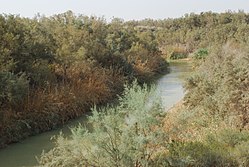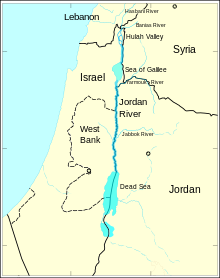
Back Jordaanrivier Afrikaans Iordan ANG Okwaan̄ Jodan ANN نهر الأردن Arabic ܢܗܪܐ ܕܝܘܪܕܢܢ ARC نهر الاردن ARZ İordan çayı Azerbaijani اوردن چایی AZB Иордан Bashkir Jordan BAR
| Jordan River | |
|---|---|
 Jordan River | |
 The Jordan River runs along the border between Jordan, the Palestinian West Bank, Israel and southwestern Syria. | |
| Native name | |
| Location | |
| Country | Jordan, Israel, Syria, Israeli-occupied Palestinian territory of West Bank |
| Region | Middle East, Eastern Mediterranean litoral |
| Physical characteristics | |
| Source | Confluence of Hasbani River and Dan River |
| • location | Sde Nehemia kibbutz in northern Israel |
| • coordinates | 33°11′15″N 35°37′10″E / 33.18750°N 35.61944°E |
| • elevation | 70 m (230 ft) |
| Mouth | Dead Sea |
• elevation | −416 m (−1,365 ft) |
| Length | 251 km (156 mi) |
| Discharge | |
| • location | Dead Sea, Jordan Rift Valley |
| Basin features | |
| Tributaries | |
| • left | Banias River, Dan River, Yarmouk River, Zarqa River |
| • right | Hasbani or Snir River, Iyyon Stream |
 | |
The Jordan River or River Jordan (Arabic: نَهْر الْأُرْدُنّ, Nahr al-ʾUrdunn; Hebrew: נְהַר הַיַּרְדֵּן, Nəhar hayYardēn), also known as Nahr Al-Sharieat (Arabic: نهر الشريعة), is a 251-kilometre-long (156 mi) endorheic river in the Levant that flows roughly north to south through the Sea of Galilee and drains to the Dead Sea. The river passes by or through Jordan, Syria, Israel, and the Palestinian territories.
Jordan and the Israeli-occupied Golan Heights border the river to the east, while Israel and the Israeli-occupied West Bank lie to its west. Both Jordan and the West Bank derive their names in relation to the river. The river holds major significance in Judaism and Christianity. According to the Bible, the Israelites crossed it into the Promised Land and Jesus of Nazareth was baptized by John the Baptist in it.[1]
- ^ "An Interfaith Look at the Jordan River". 25 July 2013. Archived from the original on 18 April 2017. Retrieved 16 January 2017.